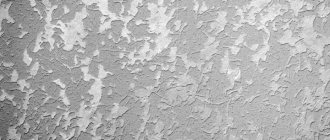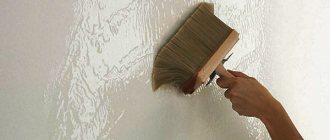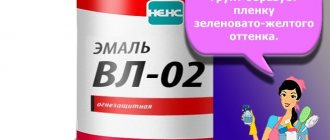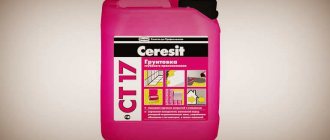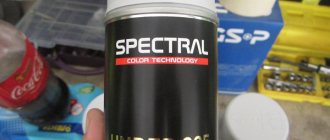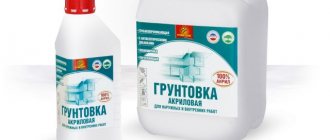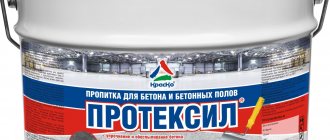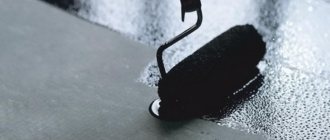Even beginners in the field of construction and decoration know that a residential building should not only have excellent functionality, but the appearance and design of the facade is also of great importance. A very popular option is plastered and painted walls, which will remain attractive for a long time if a primer is used during finishing work. Nowadays, there are many different primer compositions; such a variety can confuse both a novice finisher and even an experienced craftsman. One of the high-quality, reliable and proven primers is ceresit primer, which has several modifications. This article will take a closer look at 2 types of Ceresit primer.
What are Ceresit primer mixtures?
These compositions are universal, they have a water-dispersion base, are made from synthetic resins, and are very popular because they penetrate deeply into the substrate being treated, be it plaster, putty or a brick wall. Thanks to their use, adhesive characteristics are improved, and the walls do not dry out prematurely, so cracks do not form, which could lead to rapid destruction of the finish.
There are several varieties of Ceresit soils, each type has its own technical characteristics, scope of application, functionality, each variety has a different consumption per 1 square meter. The most popular modifications are ceresit primer st 17 and st 16. In addition to these, grade 19 is also produced, which is used for treating concrete buildings before plastering them. Each of the modifications meets high standards and requirements and has all the necessary certificates confirming high quality.
Primer characteristics
The base color of the product is white, but it is possible to add tinting pigments according to the manufacturer’s card (color primers are made to order). You can also tint the Ceresit ST 16 primer yourself, which is sometimes required when carrying out plastering work with colored plaster.
A description of the technical characteristics of the material is given below:
- The structure is thick, homogeneous, without foreign inclusions.
- Temperature when applying the product is +5...+30 degrees, relative humidity - no more than 80%.
- Drying time for one layer is 3 hours.
- The density of the product is 1.5 kg/cu. dm.
- The speed at which the surface will absorb the primer is less than 0.5 kg/sq. m/hour*0.5.
Consumption of funds
Before treating surfaces inside or outside the house, you should check the consumption rates per 1 m2. This will help you purchase the right amount of primer. Consumption strongly depends on the surface's ability to absorb water and will range from 200 ml to 500 ml per square meter.
Ceresit ST 16
This type of primer composition is widely known among specialists in the field of finishing. This primer is made on a water-dispersion basis. It is used when performing interior and exterior finishing work; this modification can only be applied to a prepared base, before applying plaster. Thanks to the use of this primer product, it is possible to qualitatively prepare the base being treated, which will guarantee its strong and reliable adhesion to the finishing material, so the coating will be functional and attractive for many years.
Material properties
Ceresit CT 16 primer is a type of finishing material on a water-dispersion basis, which is intended to prepare the base for subsequent finishing. This brand of primer is universal - it is ideal for use under facade paints, decorative plasters, and is useful for interior and exterior work. Application of primer guarantees the longevity and reliability of the coating in the future.
The properties and features of the material are as follows:
- improvement of adhesion indicators - adhesion to other coatings;
- optimization of the finishing coating application process;
- providing protection from moisture - the surface acquires water-repellent qualities;
- deep penetration into previous layers during finishing work.
Adhesion due to coating with the material is improved due to the inclusion of mineral (quartz) sand in the composition, which gives the surface roughness. The primer does not cause a decrease in air permeability, is environmentally friendly, does not contain solvents and does not have an unpleasant, pungent odor. It is completely ready for use, which is very convenient for the user. The package contains 5 or 10 kg of soil, the cost of a smaller container is about 500 rubles.
Where is ST-16 used?
It is used only before applying decorative plaster, for example, bark beetle. The scope of application is very diverse; it can be applied to the following surfaces before finishing work:
- gypsum plasters;
- concrete bases;
- cement-sand and cement-lime buildings;
- wooden and plasterboard;
- various paint and varnish coatings that adhere firmly to walls or ceilings.
In addition to all of the above, the primer can also be used to treat the protective layer when installing Ceresit facade insulation systems.
Attention! This type is used for decorative plaster, since the composition contains very fine quartz sand, which makes the primed base rough. A slight roughness significantly increases the adhesive properties of the decorative coating.
Scope of application of the primer
Most often, the material is used to prime various bases made of concrete, mineral coatings, cement walls and floors, gypsum, and plasterboard products. It is also suitable for processing lime and other types of plaster, cellular concrete, and particle boards.
Since the primer does not allow the base color to show through a thin layer of plaster, it is often used in finishing work. Its use in bathrooms is indicated, as it protects the base from dampness. Similarly, protection against the effects of precipitation on the street is provided.
In addition to the indicated areas of use of this material, it can be used for:
- arrangement of facade insulation systems;
- priming the reinforced layer before laying decorative plaster;
- applied to the coating before painting it with acrylic, water-based, oil paints.
The primer significantly improves the adhesion and quality of application of silicone and wallpaper adhesives. Such a wide range of possible works makes Ceresit ST 16 in demand among ordinary users and professional builders.
Characteristics and consumption of ST 16
This modification is made in white, but if necessary, you can use tinting to achieve the desired shade; the color card offered by the manufacturer can be used for tinting. The consistency is homogeneous, has a thick structure, the liquid is completely ready for use, does not require dilution or any other preparation. The structure is an aqueous dispersion of several acrylic copolymers, and also contains mineral fillers and pigments.
This deep penetration soil is consumed differently, depending on the type of surface. If the base quickly absorbs, then the consumption will be increased. Usually about 200-500 grams per m2 are consumed. Applying the composition is allowed at air temperatures of 5-30 degrees. Depending on the ambient temperature, how long it will take for the liquid to dry will depend. Typically drying time is no more than 3 hours.
Application of the product
In accordance with the instructions, CT 16 primer does not need to be diluted. After opening, stir it well enough in the same container. It is better to apply the composition with a brush in an even thin layer, in order to avoid exceeding the consumption rate and the formation of drips. Typically no more than one coat is required.
It will take about 3 hours for the primer to dry completely, then you can begin subsequent work. To get the desired result, you must maintain a temperature of +20 degrees and a humidity of 60%. If the primed surface has dried thoroughly, then there will be no scratches left on it from the rib-iron grater.
Uncured remains of the primer material can be easily removed with water. If the soil has dried out, the errors can only be removed mechanically (using an angle grinder).
Taking into account all the recommendations, you can achieve a high-quality and wear-resistant surface result, regardless of which side the work was carried out on.
Properties and advantages of ST 16
This modification is of high quality; it simultaneously performs several important functions, thanks to the following unique properties:
- significantly increases the adhesion strength of the base and plaster, due to improved adhesive properties. The adhesion rate is increased due to the fact that the composition contains fine sand, which makes the base rough;
- although the base color is white, you can tint the composition using additives. It is especially necessary to repaint it when colored decorative plaster is applied. In this case, in order to prevent translucency, it is important that the color of the primer matches the color of the finish;
- reduces the moisture content of the base on which it is applied, thereby achieving the best drying conditions;
- the composition does not contain synthetic solvents, so the product is environmentally friendly and safe for human health;
- the liquid is completely ready for use, it does not require additional preparation, it is quick and easy to apply using a regular brush or roller.
Application rules
Before applying primer, it is important to thoroughly clean the ceiling or walls of any contaminants, including dust and grease stains, which could reduce adhesion properties. It is also necessary to remove all irregularities, and if there is moss or algae, then cleaning should be carried out using a steel brush.
Attention! It is important to protect those places that will not be treated with primer, for example, door openings, window frames and others, for example, with masking tape.
Before application, the primer composition does not need to be diluted with water or other liquid; just shake the packaging and prepare a roller or brush. If liquid gets on the laying surface during the work, it can be washed off with ordinary water, and after drying it can be removed with a solvent.
Ceresit ST 17
This deep penetration primer is universal, so it can be used to treat all types of external and internal surfaces. The technical characteristics of the Ceresit St 17 primer allow it to be used for the following purposes:
- to reduce the moisture content of the base before gluing, laying tiles or stone tiles;
- strengthening the walls before applying a layer of plaster;
- treating floors before using leveling floor products;
- processing of gypsum plaster or cellular concrete walls;
- strengthening bases on which water-based or acrylic paints are applied;
- processing of wood chipboard and plasterboard materials;
- before painting the building or installing insulation boards;
- processing of cement-bonded, brick buildings, as well as those products that are treated with formaldehyde products.
Many experts believe that before wallpapering, it is necessary to prime the walls. This opinion is justified, because priming products protect walls from destruction and improve adhesive properties.
Characteristics of ST-17
This product consists of water-soluble polymers and synthetic resins that have a yellowish tint. This product must be applied in a temperature range of 5-35 degrees. For the applied layer to dry completely, it takes an average of 4-6 hours, this indicator completely depends on the temperature. The primer consumption per 1 m2 depends on how quickly the base absorbs moisture. When applied in one layer, the consumption is usually 100-200 grams per square meter.
Products are supplied in containers of 17l, 10l, 5l and 1l. The larger the volume of the canister, the lower the cost per liter. Since the primer is universal, it is suitable for treating walls before gluing insulating material, and it can also be applied to insulating materials. Thanks to the versatility of Ceresit primer, there is no need to purchase several different priming products. There are two versions available - winter (frost-resistant) and summer.
One of the important characteristics of these products is the significant improvement in adhesive ability. Due to the fact that this liquid is deeply absorbed into the base being treated, the finish will not peel off or fall off, even after many years. A large number of very small particles that have binding properties enable the product to glue at the molecular level the smallest grains of dust, grains of sand, various impurities and materials, due to which the surface becomes not only durable, but also very smooth. Since this liquid does not contain any solvents, it is environmentally safe for human health.
This mixture differs from similar products in its antiseptic characteristics; it protects against the appearance of fungi and mold, and also makes the buildings being treated protected from moisture absorption. The primer does not reduce vapor permeability, so it can be used for application to screeds that are equipped with heating.
Surface preparation and application of ST 17
Before applying this modification, it would be useful for everyone to familiarize themselves with the following recommendations. It is very important to take the preparation of the foundation responsibly. Preparation includes the following steps:
- All weak, crumbling areas are removed using a brush with steel bristles.
- Leveling is carried out in order to remove all sagging and irregularities.
- Traces of biological corrosion, mold, and fungi are eliminated; this is done either mechanically or through treatment with special substances.
- The surface is thoroughly cleaned of dust, dirt, grease stains, flaking paint, and other particles that will reduce adhesive characteristics.
After completing the preparatory work, it is advisable to apply the priming liquid every other day. Before applying it, you need to shake the canister, after which you can treat the area with a brush, brush, brush or roller. It is allowed to cover surfaces in several layers. Before applying the next layer, you need to wait until the previous layer has completely dried. It is important to use the mixture in dry conditions, with air humidity not exceeding 80 percent. Upon completion of all work, all tools are thoroughly washed under running water.
Surface preparation
The prepared surface must meet the following requirements:
- be well dried;
- strong enough;
- cleaned of grease stains, limescale, mastic residue, dust and dirt.
The base must be checked for strength by feeling and tapping. Clean and sweep if necessary. Areas affected by mold and mildew must also be cleaned. For cleaning, use a steel brush, then treat with CT 99 fungicidal solution. And for grouting the surface, it is recommended to use CT 29 or CT 24 plaster.
Substrates that are particularly non-moisture resistant and can become heavily saturated with water (gypsum plasters, plasterboard, particle boards) are best initially treated with CT 17 primer.

